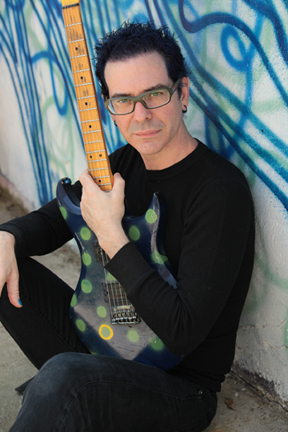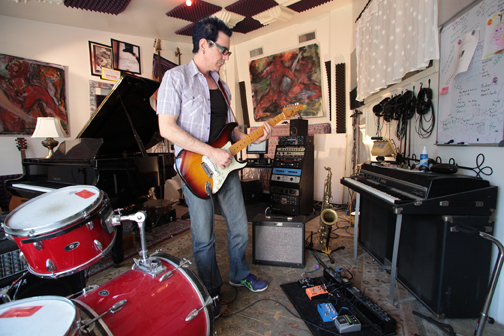
Interview with Keven Brennan
by K. Walton
KW: What's your background?
KB: I grew up in a house that always had classical music playing. That was a foundation in a sense, even though classical music is not a big part of my life now it's something that always feels familiar. When I picked up the saxophone I started playing jazz and listening to a lot of different kinds of music (thanks to the South Bend Library). It was kind of my age of enlightenment. The music buyer at the Library was very hip, so I got turned onto James Brown, Professor Longhair, Dr. John, the Meters, the Neville Brothers, Miles Davis and Herbie Hancock. James Brown, Funkadelic and Bootsie Collins was my life for a few years. Also, growing up close to Chicago kept me up on Chicago Blues. Then it was off to Berkeley School of Music for a short stint, but that wasn't a good fit for me and I dropped out to play in Punk Rock bands. The seed for Punk rock was planted in England when I was 13 years old and saw the Punk Rock scene. The simple idea of "a scene", the communal aspect to a music movement was very inspiring.
Next I stopped in at the New England Conservatory. The strongest experience I had there was studying with Rand Blake who opened up my idea to a very eclectic way of approaching my personal expression. His musical sensibilities were not bound by anything and thus they were shaped by where-ever his curiosity took him (for example, Film Noir was a big inspiration for his music). I realized that a lot of the music that I had been under a certain amount of pressure to see as wrong, or unsophisticated, was perfectly valid as part of my musical experience and education. Thus, everything I experienced was my education. I joined a rockabilly band because I was interested in the foundation of rock and roll. A guy in that band was my mentor and turned me onto all the cool 50's and 60's rock n roll. He turned me onto Lee Allen, and told me if I wanted to learn how to play rock n roll sax I should listen to Little Richard. Rand Blake affirmed the value of my search for all these different and diverse styles and influences of music.

KW: What makes you tick?
KB: A sense of achieving a higher connection with another human being, like when I'm playing with a group of musicians and it reaches an energy point that bonds us and is so tight that it's almost spiritual.
KW: Did you make a conscious decision to be a producer?
KB: Yes, I did. There is a certain creative process that the producer is responsible for and I enjoy that process, it's fulfilling. It starts with having really good building blocks and working with the elements that are there, and so it's just it's own creation. I get a certain degree of satisfaction out of singing and writing songs, and playing saxophone in a band, but I think there's something that's very full and complete when I'm working with an artist, contributing as a musician and composer, and not unlike a movie director defining the visual and sonic landscape. I'm also very interested in the historical and social impact of the music; exploring why it is important, and how it reflects our attitude or place in the world.
KW: You work with a variety of artists and musical genres. How do you decide where to start with an artist?
KB: There's another element that I really enjoy in the producer field: the personal interaction with the artist/band. That interaction requires you to listen, and to be sensitive to and perceive the artist's motivations and inner inspirations... sometimes before they even see it themselves. I look for that thing in an artist that is special and unique; a pearl in the center of their being. An example of this is with Monk's new record "Won't Bow Down." There's a tune called "Footsteps" that I think illustrates what I do best with artists. It's a story that I knew he had in him, and in the end it probably best reveals all of his innate charisma better than anything before.
KW: You've definitely got your own sound. How would you describe it and how does it influence your work with an artist?
KB: Well, I love textures, obvious and hidden, that illustrate the big picture and the details. They are like little surprises, or flavor bursts, that can go unnoticed which is completely fine (that's part of the beauty of it), but you can notice those things and it adds to an enjoyment. Van Gogh had his pallette of colors and you can tell it's his painting largely based on his color choices... prussian blue with dark outlines, that's Van Gogh. So, with my solo project "Stand in the Light" there is a good deal of dense orchestration, and by contrast Monk's new record is not; however, they are similar in their emphasis on the rhythmic expression. For me, the songs have to have a very clear rhythmic focus, and that's my most significant influence.

KW: Can you give me an example of an artist you've produced and how that process went?
KB: Working with Janeen Leah [f.Boo artist] is a perfect example of one way I work with an artist and one who doesn't live in Los Angeles. Janeen will write a song and do a simple two track recording on her computer with vocals and guitar, and then she emails that to me. I listen to the track and talk with her over the phone about the vibe of the song and what I hear for it. Then I go to work laying down the tracks. I send her a rough mix so that she can rehearse and get the song with it's full production into her body. Then we either arrange for her to fly into Los Angeles for one day to record the vocal or arrange a session with a studio in her area and have the track sent down for my final mixing.
Check out the before and after of Janeen Leah's song "Let this Love Die":
KW: Your studio is very warm and vibey, and you've got your console set-up in the main recording room. I understand you moved it from a separate control room into the main room. Why did you do that?
KB: A couple of reasons drove moving it: the control room was too small to mix in for the bass response, and I was spending way too much time going between the control room and the main recording room. I much prefer being in the recording space with the artist. It's more of a collaboration, so much more intimate and optimal for communication. And it helps put the artist at ease, reducing the pressure of performing.
KW: For the gearheads, what gear do you like to work with? And if you could invent anything you needed or wanted for your studio what would it be?
KB: The preamps I use for drums are my Neve and Aurora Audio, which are practically my favorite preamps. I love ribbon and tube mics, analog pedals and funky old stuff like spring reverb. As my invention, it would be a 3 dimensional, interactive, in the air, touch screen (like they have on CSI) mixing console interface between the computer and all the gear (digital and analog).
KW: Who's the coolest musician you've worked with to date?
KB: I think Greg Leizs, Jim Keltner, and Dr. John are very cool and stand out. Maceo Parker is up there too. You get why these guys are giants and there's no mistaking they are a force.
KW: If you could have any line-up (dead or alive) for the next record you produce, who would it be?
KB: Stevie Wonder on voice and keys, Sonny Rollins on sax, Jim Keltner on drums, Louis Armstrong on trumpet, Bill Summers on percussion, Bootsie and Catfish Collins on bass and rhythm guitar, along with me playing rhythm guitar... hee-hee-hee, oh and Bennie Maupin on bass clarinet, and Allen Ginsberg's spoken word poetry.
Producer and Composer Credits
Artists and CDs Produced:
Winter Wind (Bonnie Murray Tamblyn)
Shireen Amini
Janeen Leah
Big Chief Monk Boudreaux
Reverend Goat Carson
Big Chief Monk Boudreaux and
John Lisi & Delta Funk
Ru Williams of the Uppressors
Adam Benjamin
Abri van Straten
The Return of Eve (Colleen Duffy of Devil Doll)
God Is A Mighty Gourd (Keven Brennan)
Revival Tent (Keven Brennan)
Dada Spots (Keven Brennan)
Beatnik Gumbo (Keven Brennan)
I'll Be Home for Christmas (Robin Brennan)
Last Diary of a Torch Singer (Robin Brennan)
Lullabies for the young at heart (Robin Brennan)
Shakytown (Daniel Mackenzie)
Bulldog Girls at the Dresden (Judy Nagy)
Product Jingle Placements & Demo's:
GMC
Coca-Cola
Songs in Films & Television:
- Kville - "Mardi Gras in New Orleans"
- Discovery Channel - Travel Channel
- "The Journey"
- "Just Jiggle"
- "Ocean's Levity"
- " Who's Drivin' This Train"
- Townies (Independent Feature)
- "Drivin’ Around"
- "God Is So Good"
- Good Neighbor / Killer Next Door
- (Feature Starring Billy Dee Williams)
-
- "Blow Mi Mynd"
- "Friends of My Old Flame"
- Single Family Dwelling (Award Winning Short Film)
- "Blow Mi Mynd"
- "Pussycat Galore"
Audio Book, Gaming, and Industrial Voice Over Recording & Editing / Music Score / Songs:
- Coresoft Playstation
- English Exchange "English as a Second Language"
- BTS / Advantage Performance Group Corporate CD
- Connie Kaplan's, Genersity Inc. books on CD
- Gayle Bull Dixon's audio book -
- Shirley Windward's Poetry on CD
- Bryant & Johnson - Main Title Demo Reel
- "When I Go Crazy" (closing credits)
Internet Composer (composer & engineer for all music and audio):
- Expressit.com (Mattel)
- 3D animated greeting cards
Keven Brennan & Dan Mackenzie
Scoring for Television
Discovery Channel:
- "The Twisted Lives of Contortionists"
- On the Inside series:
- "Las Vegas Weddings"
- "Vegas Nights"
- "Riverboat Gambling"
- "Lotteries"
- "Bodybuilding"
- "L.A. Coroner"
- "Luggage"
- "Private Jets"
- "Future Guns"
- "Mall of America"
MSNBC:
- "Reality TV Survivor’s Guide"
- "Food and Romance"
Scoring – Film:
"Super Saver" (independent)